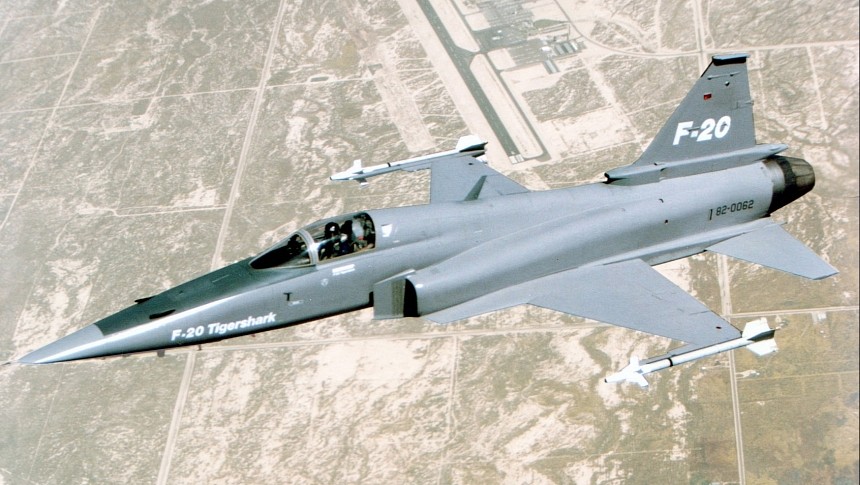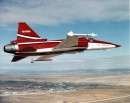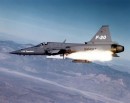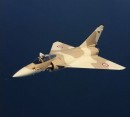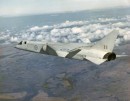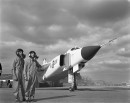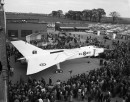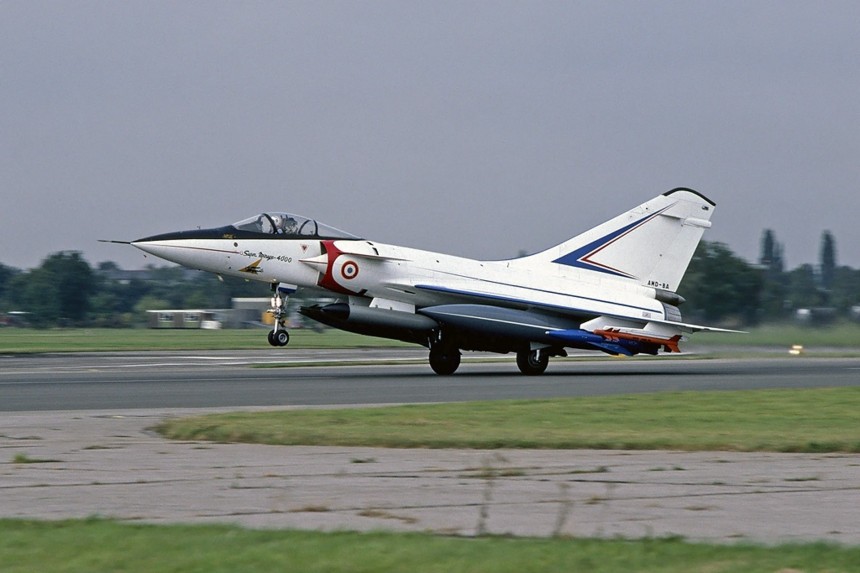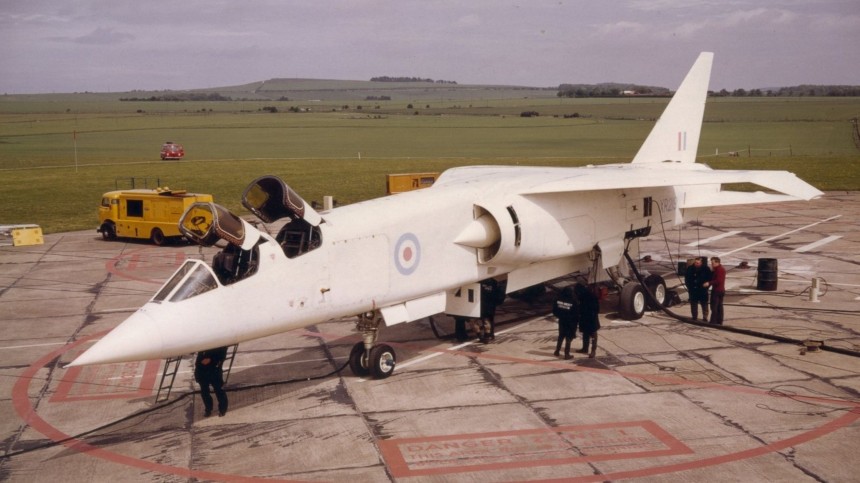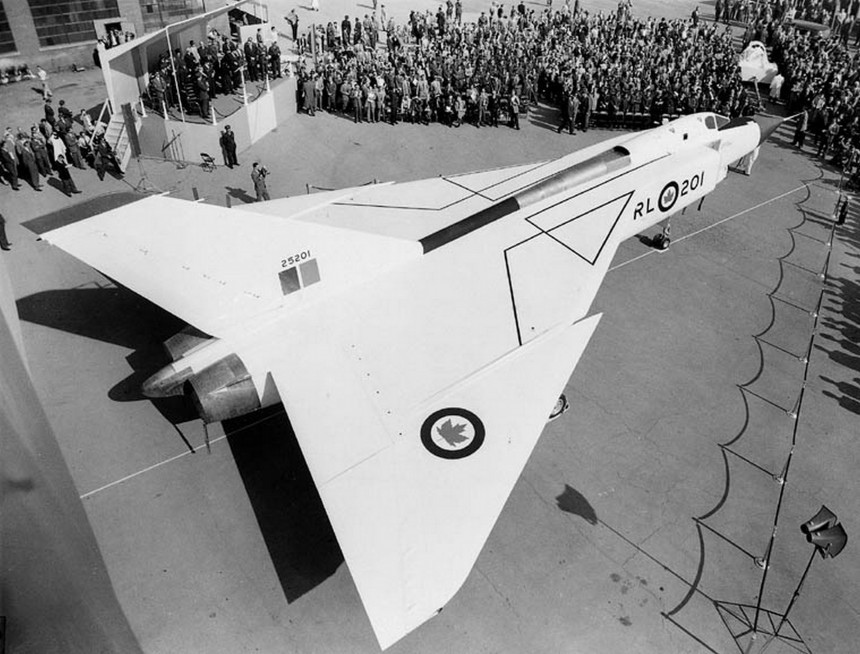When a NATO-affiliated military wants something, it gets it, right? With hundreds of billions in taxpayer funds to sift through across 31 member states, you may find it interesting that even NATO doesn't get its way 100 percent of the time. In fact, we bet there's a consortium of admirals, commanders, and general Pentagon pencil pushers who lament the planes that got away. Today, let's dive into a few military jet prototypes that NATO decided not to add to the military-industrial complex.
But first, a little disclaimer. This article only includes once-airworthy jet fighters that were slated to enter full-scale production before being canned at the last moment. So no experimental VTOL nonesense here toady. With that in mind, let's get started.
The only sin the Northrop F-5 twin-engine light fighter ever committed was living in the shadow of the F-16 Fighting Falcon. Completely unloved in American service in all but its T-38 Talon trainer variant, The F-5 had to look for work outside the USAF for the jet to be remotely profitable for Northrop. That said, the F-5 was a phenomenally adaptable platform, one that benefitted tremendously from a comprehensive upgrade package.
Designed to dogfight Soviet fighters over the skies of the Third World War, the F-20 Tigershark took a bare-bones, old-school fighter jet platform and made it even better at its job. The upgraded F-20 sported a single, massive General Electric F404 turbojet engine instead of the F-5 twin-engine setup for faster acceleration and a higher service ceiling. It also added trinkets to like more robust air-to-ground capability and the ability to fire beyond-visual-range AIM-120 AMRAAM air-to-air missiles for over-the-horizon attacks.
Couple that with the AN/APG-67 pulse Doppler pulse radar famous nowadays for its use in South Korea's T-50 Golden Eagle, and Northrop Aviation had a supremely capable combat platform on its hands. I.e., the kind of jet that could legitimately slug it out with Su-27s and MiG-29s and live to tell the story. If only anybody in the world even wanted it. When testifying before Congress in March 1984, a Reagan administration member named William Schneider Jr testified that the FX program that birthed the F-20 was unlikely to yield domestic or foreign sales.
Couple that with two test pilots losing their lives by blacking out in low-altitude, hard-G maneuvers during flight testing that destroyed two of the three experimental F-20 prototypes. It was a recipe for the complete end of the program. The remaining Tigershark was delegated to museum duty by the start of the 1990s. It shows that even an outstanding jet fighter can get lost in the shuffle among a swarm of heavyweights.
Though we tend to forget it today, Iran very much used to be an ally of the West in the Middle East until the late 1970s. Before the fall of the Shah, global aerospace manufacturers were chomping at the bits to supply the Iranian Air Force with their own aerial hardware. The most famous case by far is the American Grumman F-14 Tomcat, a jet no doubt retired prematurely by the U.S. Navy to mitigate black market acquisition of Tomcat parts by post-Shah Iranian state agents. But it wasn't the only one.
The Dassault Mirage 4000 was once pegged as a candidate to supplement squadrons of Iranian F-14s before the fall of Western-friendly Iran. As a privately-funded-twin-engined evolution of Dassault's much-lauded Mirage 2000, the Mirage 4000 was considerably larger in both weight and size than its forbearer. This extra size was no accident. All that surface area beneath the Mirage 4000 was intended to accommodate everything from American Sidewinder and French Matra Magic air-to-air missiles, air-to-ground-missiles, unguided rocket pods, and up to 27 551-lb (250 kg) unguided bombs.
As a true-to-form, multi-role strike fighter, the Mirage 4000 was like a Mirage 2000 on a max dose of "gear." Taking its first flight on March 9 with Dassault's test pilot Jean-Marie Saget at the controls, the Mirage 4000 was found to be nothing short of a spectacular platform. A brutish leviathan of a machine that could sit still on a runway one moment and, roughly three minutes and 50 seconds later, be flying near twice the speed of sound and well on its way to 50,000 feet in the air. It was all thanks to two of the same Snecma M 53 turbojet engines found in the Mirage 2000 and specific variants of the Mirage F1.
It all looked fantastic on paper, but not even a month before the Mirage 4000's maiden flight, the Iranian regime most suited to purchasing the airframe had gone up in smoke, taking their American F-14 Tomcats with them. Meanwhile, efforts to court the Saudi Arabians with the Mirage 4000 also failed. By the turn of the 1980s, the Mirage 4000, like the F-20 Tigershark, was relegated to museum service, on display at the Paris Air and Space Museum next to the Paris–Le Bourget Airport.
There was a time in the distant past when the Royal Air Force didn't rely on its NATO allies to supply most of its aircraft. In the mid-1960s, British aerospace firms were designing and building genuinely ambitious airplanes on par with French, West German, and American projects. Want proof positive? Besides the original Harrier, look no further than the BAC TSR-2, an aircraft that will one day get its own feature here, no doubt.
As a mammoth 103,500-lb (46,947 kg) British bulldog of a strike fighter, a la the American F-111 Aardvark or the Soviet Sukhoi Su-24, the TSR-2 was one of the most ambitious aerospace projects ever to fly out of Great Britain. Though most well suited for high-speed reconnaissance, a bit like the American SR-71, the TSR-2, though a bit slower than a Blackbird, differentiated itself by carrying up to 10,000 lbs (4,500 kg) of weapons inside its bomb bay and on external pylons. That includes a single Red Beard 15-kiloton nuclear bomb, mind you.
With two Bristol Siddeley (Rolls-Royce) Olympus engines jetting over 60,000 lbs of thrust combined at full afterburner, the TSR was theoretically every bit as capable as any American equivalent reconnaissance jet, save for the SR-71 as mentioned above. But compared to less extreme aircraft like the North American A-5 Vigilante and the General Dynamics F-111A, there wasn't much difference in raw flight performance between the trio whatsoever, if not weapons platforms and operation costs, in which the F-111 was superior.
Of course, it was the F-111A that replaced the TSR-2 in the RAF's plans when that recurring nagging problem in British aviation called cost overruns reared its ugly head. Ultimately, it was determined via a debate in the British House of Commons that General Dynamic's solution to a high-speed strike jet would be more practical to operate in the long run than what British Aircraft Corporation had brought to the table. Ironically, the F-111A became something of an afterthought in U.S. Air Force service, only being christened unofficially with the Aardvark nickname upon the day of its formal retirement. Coincidentally, the Navy variant F-111B, like the TSR-2, never served a day in operational service.
Is there anything that hasn't been said about Canada's one and only domestically produced supersonic military jet? We've already covered the unfortunate circumstances behind the tragic demise of the Arvo Arrow program and the respectable but foolhardy attempt to upgrade it with modern tech around 15 years ago. But come on, what list of "the one that got away" fighter jets would be complete without the Arrow? If nothing else, it's a perfect opportunity to talk about one particular aspect of the Arrow's mythos.
The Northrop F-20, Dassault Mirage 4000, and the BAC TSR-2 may have been fabulous airplanes, but none of those carried the weight of national pride for their home nation the way the CF-105 Arrow did. It's said the cancelation of the Arrow program was the defining legacy of Canada's 13th Prime Minister John Diefenbaker. Though famous for passing the Canadian Bill of Rights and several civil rights reforms during his tenure, it seemed as though any goodwill the Diefenbaker administration may have had with the Canadian public all but vanished when the CF-105, Orenda Iroquois turbojet engines and all bit the proverbial dust.
With no domestic supersonic fighter to speak of during the 1960s and beyond due to the Arrow's termination, Canada's been forced to manufacture license-built copies of American jets like the F-104 Starfighter and the F-18 Hornet to stock its Air Force with contemporary hardware. In a NATO alliance rife with interesting fighter jets that are points of national pride, it's a stain upon the Royal Canadian Air Force that, although they might not mind so much, the public at large sure as heck notices.
With the F-35 now slated to form the bulk of the RCAF's front-line aerial fighting force, it's just the latest in a series of events directly related to John Diefenbaker's career-altering decision to strip Canada of a national symbol of strength that it seems to have little chance of ever getting back. For that reason, the Arrow stands head and shoulders above the rest.
Nothrtop F-20 Tigershark: A dragster in the sky made faster and better
Designed to dogfight Soviet fighters over the skies of the Third World War, the F-20 Tigershark took a bare-bones, old-school fighter jet platform and made it even better at its job. The upgraded F-20 sported a single, massive General Electric F404 turbojet engine instead of the F-5 twin-engine setup for faster acceleration and a higher service ceiling. It also added trinkets to like more robust air-to-ground capability and the ability to fire beyond-visual-range AIM-120 AMRAAM air-to-air missiles for over-the-horizon attacks.
Couple that with the AN/APG-67 pulse Doppler pulse radar famous nowadays for its use in South Korea's T-50 Golden Eagle, and Northrop Aviation had a supremely capable combat platform on its hands. I.e., the kind of jet that could legitimately slug it out with Su-27s and MiG-29s and live to tell the story. If only anybody in the world even wanted it. When testifying before Congress in March 1984, a Reagan administration member named William Schneider Jr testified that the FX program that birthed the F-20 was unlikely to yield domestic or foreign sales.
Couple that with two test pilots losing their lives by blacking out in low-altitude, hard-G maneuvers during flight testing that destroyed two of the three experimental F-20 prototypes. It was a recipe for the complete end of the program. The remaining Tigershark was delegated to museum duty by the start of the 1990s. It shows that even an outstanding jet fighter can get lost in the shuffle among a swarm of heavyweights.
Dassault Mirage 4000: If the Mirage 2000 ate a Super Mario Mushroom
The Dassault Mirage 4000 was once pegged as a candidate to supplement squadrons of Iranian F-14s before the fall of Western-friendly Iran. As a privately-funded-twin-engined evolution of Dassault's much-lauded Mirage 2000, the Mirage 4000 was considerably larger in both weight and size than its forbearer. This extra size was no accident. All that surface area beneath the Mirage 4000 was intended to accommodate everything from American Sidewinder and French Matra Magic air-to-air missiles, air-to-ground-missiles, unguided rocket pods, and up to 27 551-lb (250 kg) unguided bombs.
As a true-to-form, multi-role strike fighter, the Mirage 4000 was like a Mirage 2000 on a max dose of "gear." Taking its first flight on March 9 with Dassault's test pilot Jean-Marie Saget at the controls, the Mirage 4000 was found to be nothing short of a spectacular platform. A brutish leviathan of a machine that could sit still on a runway one moment and, roughly three minutes and 50 seconds later, be flying near twice the speed of sound and well on its way to 50,000 feet in the air. It was all thanks to two of the same Snecma M 53 turbojet engines found in the Mirage 2000 and specific variants of the Mirage F1.
It all looked fantastic on paper, but not even a month before the Mirage 4000's maiden flight, the Iranian regime most suited to purchasing the airframe had gone up in smoke, taking their American F-14 Tomcats with them. Meanwhile, efforts to court the Saudi Arabians with the Mirage 4000 also failed. By the turn of the 1980s, the Mirage 4000, like the F-20 Tigershark, was relegated to museum service, on display at the Paris Air and Space Museum next to the Paris–Le Bourget Airport.
British Aircraft Corporation TSR-2: Queen Lizzie's Supersonic Strike Jet
As a mammoth 103,500-lb (46,947 kg) British bulldog of a strike fighter, a la the American F-111 Aardvark or the Soviet Sukhoi Su-24, the TSR-2 was one of the most ambitious aerospace projects ever to fly out of Great Britain. Though most well suited for high-speed reconnaissance, a bit like the American SR-71, the TSR-2, though a bit slower than a Blackbird, differentiated itself by carrying up to 10,000 lbs (4,500 kg) of weapons inside its bomb bay and on external pylons. That includes a single Red Beard 15-kiloton nuclear bomb, mind you.
With two Bristol Siddeley (Rolls-Royce) Olympus engines jetting over 60,000 lbs of thrust combined at full afterburner, the TSR was theoretically every bit as capable as any American equivalent reconnaissance jet, save for the SR-71 as mentioned above. But compared to less extreme aircraft like the North American A-5 Vigilante and the General Dynamics F-111A, there wasn't much difference in raw flight performance between the trio whatsoever, if not weapons platforms and operation costs, in which the F-111 was superior.
Of course, it was the F-111A that replaced the TSR-2 in the RAF's plans when that recurring nagging problem in British aviation called cost overruns reared its ugly head. Ultimately, it was determined via a debate in the British House of Commons that General Dynamic's solution to a high-speed strike jet would be more practical to operate in the long run than what British Aircraft Corporation had brought to the table. Ironically, the F-111A became something of an afterthought in U.S. Air Force service, only being christened unofficially with the Aardvark nickname upon the day of its formal retirement. Coincidentally, the Navy variant F-111B, like the TSR-2, never served a day in operational service.
Avro Canada CF-105 Arrow: So good, it may have made the USAF jealous
The Northrop F-20, Dassault Mirage 4000, and the BAC TSR-2 may have been fabulous airplanes, but none of those carried the weight of national pride for their home nation the way the CF-105 Arrow did. It's said the cancelation of the Arrow program was the defining legacy of Canada's 13th Prime Minister John Diefenbaker. Though famous for passing the Canadian Bill of Rights and several civil rights reforms during his tenure, it seemed as though any goodwill the Diefenbaker administration may have had with the Canadian public all but vanished when the CF-105, Orenda Iroquois turbojet engines and all bit the proverbial dust.
With no domestic supersonic fighter to speak of during the 1960s and beyond due to the Arrow's termination, Canada's been forced to manufacture license-built copies of American jets like the F-104 Starfighter and the F-18 Hornet to stock its Air Force with contemporary hardware. In a NATO alliance rife with interesting fighter jets that are points of national pride, it's a stain upon the Royal Canadian Air Force that, although they might not mind so much, the public at large sure as heck notices.
With the F-35 now slated to form the bulk of the RCAF's front-line aerial fighting force, it's just the latest in a series of events directly related to John Diefenbaker's career-altering decision to strip Canada of a national symbol of strength that it seems to have little chance of ever getting back. For that reason, the Arrow stands head and shoulders above the rest.
